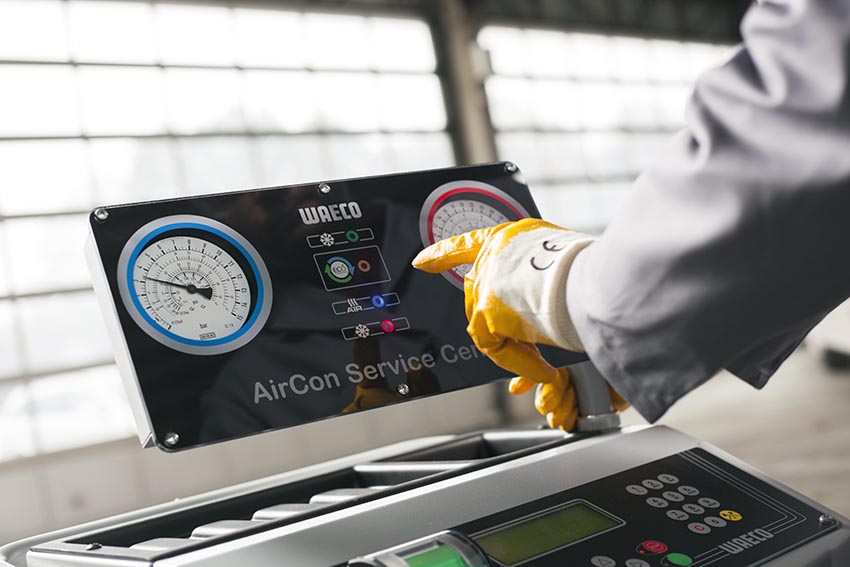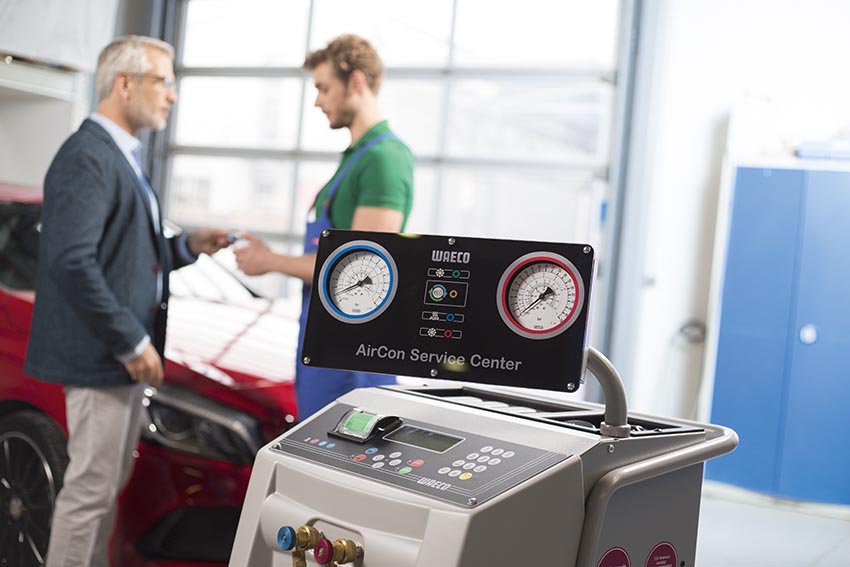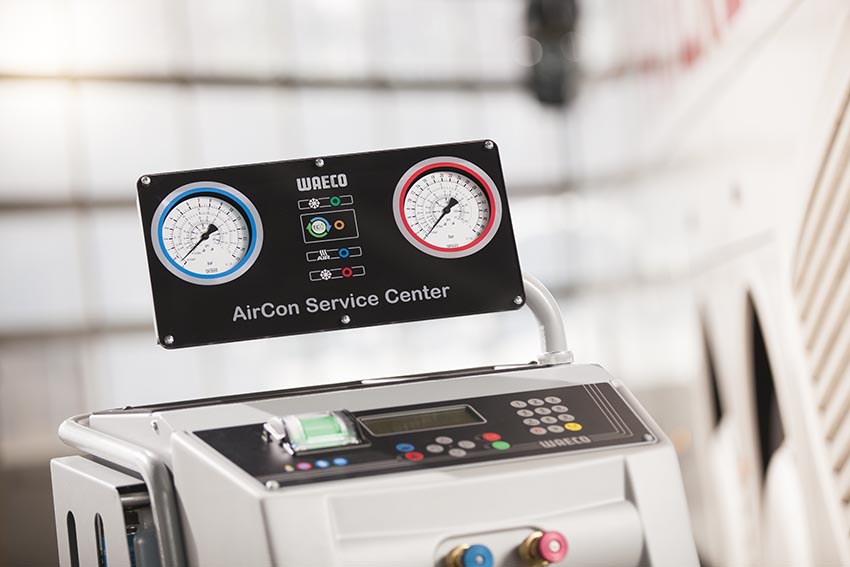WAECO products are used in specialist workshops which offer service and maintenance on vehicle air condition systems (cars, trucks, buses, agricultural and construction vehicles). The company claims the market leadership in this segment, also leading the way in terms of patented technical innovations. WAECO AirCon Service, a proprietary brand of Dometic Group, has been a recognized leader in this field for over 40 years now.
Working closely with workshop clients and the automotive industry, the WAECO AirCon Service professionals have created a full A/C service range: from fully automatic A/C service stations and efficient leak detection equipment to measuring tools, consumables and spares (original replacement parts for the automotive A/C).
Interview with Bartosz Baczynski, Sales Manager Workshop Equipment Eastern Europe at WAECO.
Easy Engineering: What are the main areas of activity of the company?
Bartosz Baczynski: Every brand is a promise. The promise of WAECO is to make daily work in A/C service workshops easier, safer, more profitable and friendlier to the environment. Living up to this commitment, the WAECO has given fresh impetus to the industry time and again. With ground-breaking innovations that give their customers a competitive edge.
Thanks to numerous vehicle manufacturer approvals WAECO is active both in many branded workshops and in the independent automotive aftermarket.

E.E: What’s the news about new products?
B.B: Formerly, most commercial vehicles used to be fitted with R134a A/C systems. Some manufacturers of trucks, buses and agricultural machinery are now moving across to the new, environmentally-friendly R1234yf refrigerant or are considering using the R513A (R134a // R1234yf blend) in order to avoid large quantities of the flammable R1234yf.
The expansion of R1234yf refrigerant brings new challenges and business opportunities to service and repair workshops also in the commercial vehicle sector. WAECO has anticipated the new market situation early on and presents a profitable and sustainable solution with its new WAECO ASC 6000 series, already featuring a triple certification for these three refrigerants.
And looking into the range for A/C parts we can proof that it is continuously adapted to the vehicle fleet – currently, for example, the range of original replacement parts is being supplemented by further e-climate-compressors.
E.E: What are the ranges of products?
B.B: WAECO’s product range is a genuine one-stop shop. It includes everything required by A/C professionals for maintenance and repairs: fully automatic service stations for vehicles of all sizes (cars, trucks, buses, agricultural and construction vehicles), reliable equipment for leak detection, air conditioner flushing and disinfection, accurate measuring instruments and handy workshop kits. WAECO also offers all necessary consumables, such as compressor oils, leak detection additives and refrigerants for R134a and R1234yf A/C systems. Plus, a complete range of custom-fit spares under the WAECO AirCon Parts brand.
WAECO products have stood the test of time for several decades now. They are appreciated by independent workshops as well as by vehicle manufacturers and their authorized workshops.

E.E: At what stage is the market where you are currently active?
B.B: The Romanian aftermarket is known for its organization and strong, professional local distributors. These companies are constantly raising the bar by providing more and more products and services to their customers in response to their changing needs. The growing popularity of electric and hybrid vehicles in Romania has prompted the industry to adapt and provide specialized services for these vehicles. Local distributors are increasingly aware of the need to evolve into modern tools and equipment for servicing electric and hybrid vehicles, including advanced diagnostic tools and specialized equipment for air conditioning service and repair. There is certainly potential here for equipping workshops with the equipment needed to service the air conditioning systems of MHEVs, PHEVs and BEVs.
The popularity of electric and hybrid vehicles in Romania is on the rise, as part of a broader trend towards more sustainable forms of transportation. Governments and consumers alike are becoming increasingly aware of the environmental impact of traditional gasoline and diesel engines and are looking for ways to reduce their carbon footprint, while on the other hand they are looking for favorable forms of financing for new vehicles through government programs, which are contributing strongly to the growing interest in EVs. This trend is expected to continue to drive growth in the Romanian automotive market in the coming year.
The Romanian automotive sector is also reporting positive developments, with an increase in new car sales over the previous year. This is a positive result compared to other countries in the Eastern European region, despite ongoing supply chain and labor shortages, as well as a deteriorating economic growth sentiment in the region.
E.E: What can you tell us about market trends?
B.B: Traditionally, the aftermarket industry has focused on addressing customer needs as they arise, through repairs and replacements of parts. However, this reactive approach is becoming increasingly less effective as customer expectations and technology continue to evolve. In order to meet these changing demands, aftermarket companies are shifting towards a more proactive approach, which involves anticipating and addressing customer needs before they arise.
This proactive approach includes a variety of strategies such as offering preventative maintenance services, providing training and education on new products and technologies, and implementing advanced analytics and tracking systems to identify and address potential issues before they occur. By taking a proactive approach, aftermarket companies can improve customer satisfaction, reduce downtime and increase the overall efficiency of their operations.
Moreover, with the growth of the Electric Vehicle market, aftermarket companies will also need to invest in new technologies and equipment, as well as in training their employees in order to service the EV market. They will also need to develop new distribution channels and marketing strategies to reach new customers.

E.E: What are the most innovative products marketed?
B.B: In addition to the standard configuration, the new WAECO ASC6000 series also provides a so called Low Emission option. The Low Emission service units achieve a refrigerant recovery rate of close to 100 percent. Using a special, 4-step process the system also recovers the refrigerant from the waste oil container and the vacuum pump, which would usually be lost. As a result, more resources are recycled and less gas can escape into the atmosphere. Moreover, the WAECO Low Emission concept produces significant cost savings on whatever type of refrigerant is being used. Thanks to these advantages for the environment, the Low Emission technology has been awarded the PartsLife Environmental Award in Germany last summer.
E.E: What estimations do you have for 2023?
B.B: According to data from the Romanian Association of Car Importers and Producers (ACAROM), the automotive market in Romania experienced significant growth in 2022. Last year, almost 130,000 new cars were registered in the country, a 7% increase compared to 2021. The market for second-hand imported cars, on the other hand, decreased by 20%, to 316,000 cars.
This trend is indicative of a shift in consumer preferences towards new cars, driven by solid economic conditions and government incentives. Additionally, the growing market for electric vehicles also plays a role in the increasing number of new cars registered.
Despite a decrease in the registration of used cars in Romania, the aftermarket industry is expected to remain stable in 2023. The high demand for replacement parts and services for existing vehicles, regardless of their age, will continue to drive the market for the automotive aftermarket industry. Additionally, even though the market for used cars may be decreasing, there are still many cars on the road that need maintenance and repairs. This creates a steady stream of customers for the aftermarket industry.

